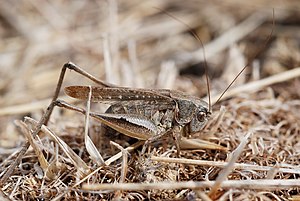Gray snake
| Gray snake | ||||||||||||
|---|---|---|---|---|---|---|---|---|---|---|---|---|

Gray snake ( Platycleis grisea ) |
||||||||||||
| Systematics | ||||||||||||
|
||||||||||||
| Scientific name | ||||||||||||
| Platycleis grisea | ||||||||||||
| ( Fabricius , 1781) |
The gray bite insect , scientific name Platycleis grisea , is a species of deciduous locust with distribution in south-east Europe, as far as the Alpine countries. It is very similar to the western bite insect ( Platycleis albopunctata ) and is considered by some systematics as a subspecies of this species.
features
The gray snake reaches a body length of around 15 to 24 millimeters. The animals are usually quite uniformly gray to light brown in color and marbled darker brown, the belly is lighter, mostly yellowish. The deck wings ( Tegmina ) are usually a little whitish spotted. The side lobes (Paranota) of the pronotum are often patterned in a coarser brown and lined with a narrow, light color. The pronotum is rarely green or ivory-colored on the upper side, but is often reddish in color. Like all representatives of the genus Platycleis (see str., Excluding the former sub-genera, which are now regarded as independent genera), the species is always long-winged; The central keel of the pronotum is only clear in the front half. In females, the dark-colored laying tube ( ovipositor ) is relatively short and evenly curved upwards. The cerci in the male are serrated on the inside a little behind the middle.
The species is very similar to its sister species Platycleis albopunctata , which is completely identical in body shape and color and with which hybrids can also occur in the southern Alps . It can only be reliably distinguished from this by a few genital features. In the female, the subgenital plate is truncated at the rear edge, roughly rectangular, and fused with the lateral sclerites. In the male, the shape of the titrators (these are movable, hook-shaped appendages on the side of the aedeagus , which serve as clamp organs during copulation) is characteristic. These are long and slender in the serrated tip section, bent back when viewed from the side, and in the basal section both touch each other over a longer distance.
The singing of the kind consists of soft, chirping four- to six-syllable verses that are strung together for several minutes. It can only be heard a few meters away. The species cannot be distinguished from its sister species on the basis of its song.
Ecology and way of life
Like the related and similar species, the gray snake lives in dry grasslands and other steppe-like, dry habitats with patchy vegetation. It also occurs in human-disturbed habitats such as railroad embankments, embankments and quarries. The species is able to fly and spreads widely. She loves warmth (thermophilic). Sexually mature animals ( adults ) occur from June to October.
distribution
The species has been proven from almost all of Italy (on the Gran Sasso up to 2000 meters above sea level), on the Balkan Peninsula , north to Romania and Hungary, south to Greece. To the east it occurs in the south of Ukraine and Russia, to the Crimea and the Caucasus. It reaches the Alpine region from the south. It occurs in the southern French Alps, in southern Switzerland (Ticino, southern Alpine valleys, Engadin) and in most of Austria, north to the Inn Valley in North Tyrol. While both species live in Switzerland, the western bite insect is almost completely absent in Austria (only an old record). The gray snake is missing in Germany (old information is incorrect and relates to Platycleis albopunctata ).
Systematics and taxonomy
The gray bite was first described by Fabricius in 1781 as Locusta grisea . It is a type of the genus Platycleis . The number and delimitation of the species, and in particular the differentiation of Platycleis albopunctata , have been unclear and controversial for decades. Until recently, the species was therefore not regarded by many authors as an independent, but as a subspecies of Platycleis albopunctata . In recent times, however, the prevailing opinion is that it is a separate species.
Individual evidence
- ↑ a b c Kurt Harz: Die Orthopteren Europe. Volume I (Series Entomologica vol. 5). W. Junk Publishers, The Hague 1969. Platycleis grisea at pages 236-240. Full text at archive.org
- ↑ a b Jürgen Fischer, Daniela Steinlechner, Andreas Zehm, Dominik Poniatowski, Thomas Fartmann, Armin Beckmann, Christian Stettmer: The grasshoppers of Germany and North Tyrol. Quelle & Meyer Verlag, Wiebelsheim 2016. ISBN 978-3-494-01670-2 , as Platycleis albopunctata grisea on page 154/155.
- ↑ a b c d Platycleis grisea at Orthoptera.ch, grasshopper platform for Switzerland and Europe, accessed on September 10, 2018.
- ↑ OS Korsunovskaya (2016): On the Distribution of the Bush Cricket Platycleis albopunctata transiens Zeuner, 1941 (Orthoptera, Tettigoniidae) in the South of European Russia and in Uzbekistan. Entomological Review 96 (3): 288-293.
- ↑ Georg Bieringer & Werner Weißmair (2017): Endangerment and protection of grasshoppers in Austria. Denisia 39: 161-180.
- ^ Alfred Kaltenbach (1964): On the taxonomy and synonymy of the Platycleis grisea species group. Annals of the Natural History Museum Vienna 67: 439–442.
- ↑ Heller, K.-G., Korsunovskaya, O., Ragge, DR, Vedenina, V., Willemse, F., Zhantiev, RD, Frantsevich, L. (1998): Check-List of European Orthoptera. Articulata Supplement 7: 1-61.
- ↑ species Platycleis grisea (Fabricius, 1781) Orthoptera Speciesfile online (Version 5.0 / 5.0), accessed on September 10, 2018.